When Shelley was little her father told her about a magical, faraway place called Monkey Mia where dolphins would meet you in the shallows of the beach and take fish from your hands. For an eight year-old girl, this sounded just like heaven. One day, she thought to herself, I will go there. I will see these extra friendly dolphins and find out why it’s called Monkey Mia instead of Dolphin Mia, because that is bothering me quite a bit.
22 years later, the day had arrived. No longer harbouring a passionate love of dolphins, but excited nonetheless, Shelley travelled with Gareth, to the westernmost point of the Australian mainland, Shark Bay. Shark Bay, a world-heritage listed area, is a hotspot for marine life. Aside from attracting dolphins and sharks, as the name suggests (don’t you love sensible, descriptive names?) its massive sea grass meadows are home to plenty of rays, turtles, dugongs, sea snakes, lotsa fish and the odd mermaid.
The tourist brochures recommended that we take the World Heritage Drive, stopping at significant sites like Hamelin Pool and Shell Beach before heading up to Monkey Mia.
Hamelin Pool had a boardwalk set over the water, showcasing a bunch of half-exposed rock in the shallows underneath. The eight-year old Shelley would have recoiled from this scene (sooooo boring) but the thirty-year-old grit her teeth and bore it, trusting that something interesting lurked beneath the well dull exterior. Turns out, we weren’t just looking at rocks, we were studying stromatolites.
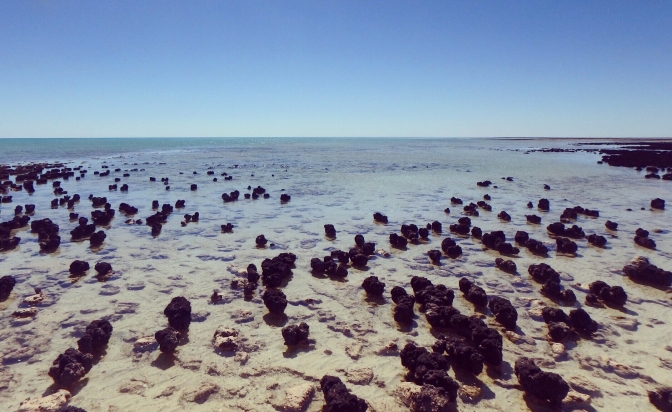
Can you believe it? Lucky ducks! For those that don’t know (what, have you been living under a stromatolite?) this sea-dwelling cyanobacteria is one of the oldest living things on the planet. Looking a lot like a rock with a toupee of mouldy carpet, these living fossils existed when not much else did – 3.5 billion years ago – and still survive in the very salty waters of Shark Bay, Western Australia.
We had stumbled upon the next piece of the evolutionary puzzle. These stromatolites release a lot of oxygen, fizzing like berocca when underwater. They contributed to the oxygen-rich atmospheric conditions that created the first single-celled creatures (about 2 billion years ago), like the ones we found in the fossils at Nilpena Station in the Flinders Ranges.
The next stop on our tour of world-heritage wonderment was Shell Beach (approved by eight-year-old Shelley cos it’s like her name). It had the standard WA paradise water, bright, clear turquoise, but the fine sand was replaced with tiny white shells creating a picturesque (and painful) beach to stroll on. The beach is made up of of just one species of cockle shell. There are so many of these shells – the beach goes on for at least 60 km -that old-timey people used them as a building material. They were sharp enough on our feet, not sure that it was the best idea to paperwalls with them in an age without electricity. Imagine trying to find feel around for the toilet on a dark night.



Our last stop before Monkey Mia was Eagle Bluff, a look out over the bay where you could see light and dark patches of water, indicating patches of sand and sea grass. Scrutinising the water from above, we saw a few shadowy shapes in the water that we convinced ourselves were reef sharks and sting rays. Keen to finally get up close and personal with the water, we sped off to Monkey Mia.
We arrived at the RACV caravan park in Monkey Mia late in the afternoon. This site is right on the beach and has the Department of Parks and Wildlife attached to it, so you can do all your dolphin watching within the resort. At reception they told us that the dolphins usually come to call about three times between 7.30am and lunchtime every day. We went for a wander to familiarise ourselves with the massive resort. Watching the sun set over the beach, we realised that a couple of dolphins were cruising around the shallows, a few metres from the sand. We took this unexpected greeting as a good omen for the next couple of days’ wildlife watching; clearly these dolphins are attention whores.


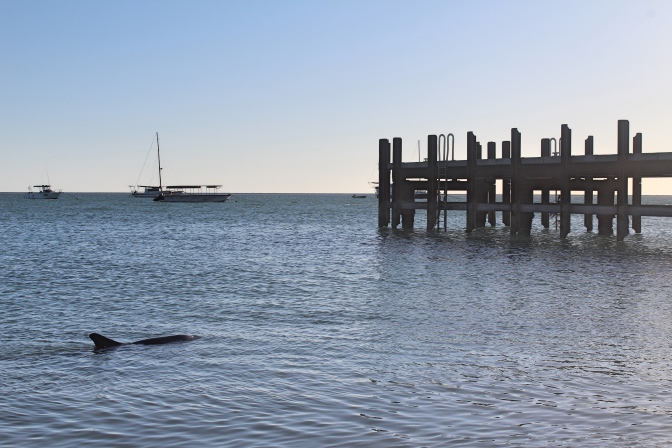
Our luck continued as we found out that Shark Bay was hosting a Science Weekend, with lectures on at the resort that evening. Excited at the prospect of hanging with marine nerds while drinking wine and eating mini-spring rolls FOR FREE, we took our places in the audience to learn about the area and its inhabitants.
Firstly, to any of you doubting the existence of climate change, you’re a moron with less intellect that a stromatolite (soz to stromatolites). Sea temperatures in this area and in the Oceania region have risen, and CO2 diffusion and storm events have increased. While this may have destroyed large swathes of sea grass in the area (Shark Bay has 10% of the world’s sea grass), the good news is that scientists are beginning to explore the potential for carbon sequestration in these sea grass meadows.
We learnt that some marine scientists have unusual research methods, such as putting Go Pros on turtles in order to monitor the quality of the sea grass, and flying kites from research boats in order to triangulate which dolphins are making the noises they are recording under water.
Dolphins themselves have unusual methods of finding food. In addition to standard techniques of hunting and herding fish, some dolphins wear sponges and giant shells on the end of their beaks to prod sediment and stir up fish without scratching themselves on the coral. The photos are quite hilarious. You should google it. We also found out that each dolphin has a signature whistle, but they all join in on dolphin-friendly tunes like the Colonel Bogey March.
The most amusing and enthusiastic scientist taught us about the wonderful world of sea snakes. This much maligned creature is very secretive and there aren’t many sea snake scientists in the world. This scientist had spent years researching them but made the final point that when it comes to sea snakes, you need to be Socratic, essentially, true knowledge exists in knowing that we still know nothing about sea snakes.
The last speaker told us more about stromatolites but by that point we’d overloaded on both information and wine. We went back to the van where Gareth made lobster risotto, a very ambitious undertaking given his condition. It tasted pretty good, but the head torch hack job job he had performed on the lobster meant that the van smelt like off lobster juice for the next few days.
We woke early the next morning to see the dolphins come in for their morning meal. There was an excitable crowd of children and adults, with special dolphin rangers attempting to keep proceedings orderly. While the rangers riffed on the personalties and life stories of the dolphins that swam in, the volunteers weighed the fish. Each dolphin is only allowed a certain amount of fish, and the male dolphins are never hand fed. They hang out behind the pier playing boy games, chasing and biting and competing for the highest jump award.
Neither of us stand out in a crowd and we weren’t lucky enough to be picked to feed the dolphins. They limit the interaction to about three people per session so that the dolphins aren’t overfed (eight-year-old Shelley was shattered). Back in the 1960-70s it was a free for all, and as a result, the dolphin mothers became lazy, opting for the fish happy meal rather than teaching their calves how to forage.

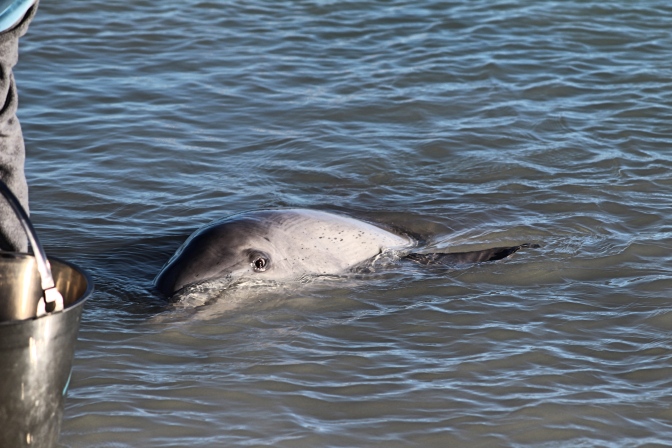




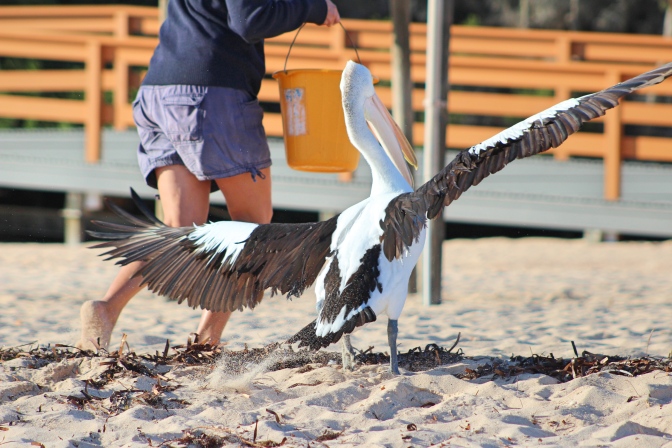


We jumped on an eco tour in the afternoon, boarding an impressive catamaran that used to run the Sydney-Hobart race and apparently still holds the title for fastest Sydney – New Zealand crossing. We spotted a number of creatures, the first being a loggerhead turtle as it came up for air.
Apparently it’s very rare to see a sea cow or dugong, as they are very shy when the captain pointed out a human-sized floater we knew we were in luck. Sea cow poo means a sea cow is close by.
And there he was! Blobbing around in a bit of sea grass, having a graze. The sea cow is an endangered species, and the recent disappearance of Shark Bay’s sea grasses is directly affecting the population.
We also saw a green turtle. These are larger and more green than the loggerheads. As a result of their size, they’re capable of impressive speed, so as we snuck up on this turtle it was startled and took off at high velocity into deeper waters. This was funny to us but probably not to them. They were hunted for more than half a century and have learned to be afraid of humans.

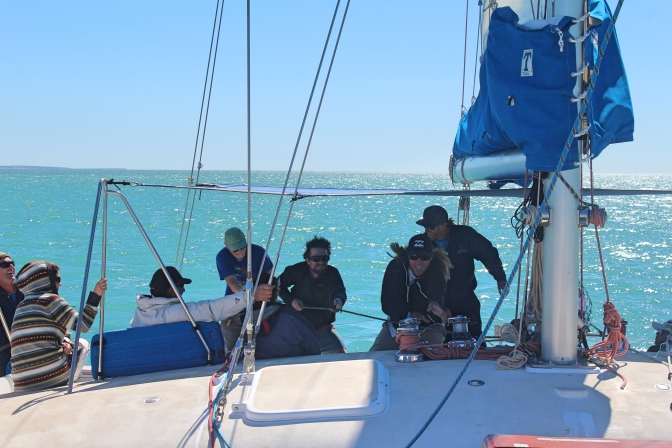





That night, aboard the same boat we grabbed a few beers and cruised along the bay to watch the sunset. We were onboard with an Irish family who clearly loved to match a song to their activity. There was a lot of David Gray ’Sail away with me’ and Annie Lennox ‘ Sail away’. The gold went to the boy though, who was about 5 and piped out quite a tuneful rendition of Calvin Harris & Disciples ‘How deep is your love’.
Monkey Mia had ‘wet’ our appetite for more of the marine world, so the next day we took off for Carnarvon, and the start of the Ningaloo Reef.


Highs: Never thought we’d be so happy to see dugong poo
Lows: Still don’t know why it’s called Monkey Mia


really enjoyed it guys and hello to the 8 year old Shelley and her imagination.
LikeLike